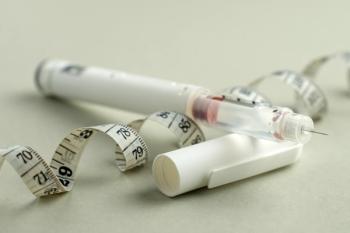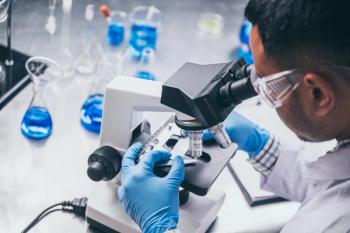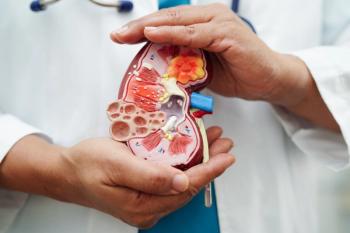
Common Cold Linked to Reduced Risk of COVID-19 Infection
Key Takeaways
- Prior rhinovirus infections may enhance antiviral gene expression, reducing SARS-CoV-2 infection risk and severity.
- The HEROS study found a 48% lower risk of SARS-CoV-2 infection following recent rhinovirus infections.
Rhinovirus infection, which causes the common cold, could offer infected children more respiratory pathway protection from SARS-CoV-2 infection.
Recent rhinovirus infection, which can cause the common cold, could offer protection against SARS-CoV-2—the virus that causes COVID-19—through increased expression of antiviral airway genes, according to new data published by investigators in The Journal of Infectious Diseases.1,2
Relationship Between COVID-19 Severity and Prior Respiratory Virus Infection
The severity of SARS-CoV-2 infection varies between patients; however, age is a major indicator of outcome severity. Accordingly, children are at generally reduced risk of severe COVID-19 outcomes or hospitalization. The current study authors recently affirmed such conclusions in the Human Epidemiology and Response to SARS-CoV-2 (HEROS; NCT04375761) cohort, determining that children have 6 times lower odds of contracting symptomatic COVID-19 compared with adults.1,3,4
Beyond abject differences in biological age causing variations in disease severity, more recent investigations suggest a novel reasoning: differences in antiviral innate immune responses. Previous researchers have observed higher pediatric innate interferon responses in children with SARS-CoV-2 infection, which can restrict disease progression and viral replication. In a similar vein, preinfection levels of antiviral innate immune genes could serve as a predictor of SARS-CoV-2 infection levels and risk, but there is a lack of comprehensive data on the topic.1,5
Although it is unclear by which mechanisms children may achieve these high innate immune levels, the current authors provided a salient example in the form of previous respiratory viral infection—specifically, rhinovirus infections, which cause the common cold and induce significant interferon responses in airways. Because children are especially susceptible to respiratory viral infections like rhinovirus, the study authors suggested that interferons produced by rhinovirus infection could prepare airways of children with significant levels of antiviral defense proteins, leading to reduced SARS-CoV-2 infection levels and more positive clinical outcomes.1
Rhinovirus Infection Protects Children From SARS-CoV-2
The authors aimed to determine the relationship between prior rhinovirus infection, subsequent SARS-CoV-2 risk, airway antiviral gene expression, and age through leveraging data from HEROS. Longitudinal data on SARS-CoV-2 and rhinovirus infections were analyzed to help better understand age-related differences in SARS-CoV-2 infection risk, viral load, and clinical outcomes, which could aid pharmacists when treating and managing these patients.1
HEROS was a prospective study of COVID-19 infection in over 1000 households across the US, conducted from May 2020 to February 2021. Nasal swabs were self-collected every 2 weeks for 6 months as part of the surveillance study. In the current study, the investigators leveraged this collection by using a case-cohort design to evaluate the circulation of respiratory viruses and their impact on COVID-19 infection. A random sample of 1000 HEROS households, with 1 member randomly selected from each, was chosen for analysis. Ultimately, the cohort contained children (30.8%), teens and young adults (20.3%), and adults (48.9%).1
Firstly, the authors examined whether SARS-CoV-2 infection risk was modulated by rhinovirus infection in the prior 30 days. An extended Cox proportional-hazards model revealed that prior rhinovirus infection was associated with a 48% lower risk of SARS-CoV-2 infection (HR, 0.52; 95% CI, 0.29-0.95; P = .034). Sensitivity analyses that better considered the timing of rhinovirus infection and symptom presence determined that more recent and symptomatic rhinovirus courses were associated with more significant reductions in SARS-CoV-2 infection risk compared with asymptomatic infections.1
Viral load was also analyzed, in which the authors found that patients with rhinovirus infection in the 30 days prior to SARS-CoV-2 had meaningfully lower COVID-19 viral load compared with patients without prior infection (95% CI, –1.63 to –0.33; P = .0031).1
“Our findings suggest that the immune boost from a recent cold may give the body an early advantage in fighting SARS-CoV-2 before it has a chance to take hold,” Max Siebold, PhD, senior study author, said in a news release accompanying the results. “This may help explain why children, who tend to get more colds than adults, generally experience fewer and less severe COVID cases.”2
REFERENCES
1. Moore CM, Secor EA, Everman JL, et al. The Common Cold Is Associated With Protection From SARS-CoV-2 Infections. J Infect Dis. 2025:jiaf274. doi:10.1093/infdis/jiaf374
2. National Jewish Health. Common cold may protect against COVID-19 according to National Jewish Health researchers. EurekAlert!. News Release. Released August 25, 2025. Accessed August 26, 2025. https://www.eurekalert.org/news-releases/1095887
3. COVID-19: Human Epidemiology and Response to SARS-CoV-2 (HEROS). National Library of Medicine. ClinicalTrials.gov Identifier: NCT04375761. Last Updated August 6, 2025. Accessed August 26, 2025. https://www.clinicaltrials.gov/study/NCT04375761
4. Seibold MA, Moore CM, Everman JL, et al. Risk factors for SARS-CoV-2 infection and transmission in households with children with asthma and allergy: A prospective surveillance study. J Allergy Clin Immunol. 2022;150(2):302-311. doi: 10.1016/j.jaci.2022.05.014
5. Yoshida M, Worlock KB, Huang N, et al. Local and systemic responses to SARS-CoV-2 infection in children and adults. Nature. 2022;602(7896):321-327. doi: 10.1038/s41586-021-04345-x
Newsletter
Stay informed on drug updates, treatment guidelines, and pharmacy practice trends—subscribe to Pharmacy Times for weekly clinical insights.



















































































































































































































